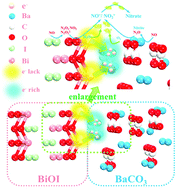Our official English website, www.x-mol.net, welcomes your
feedback! (Note: you will need to create a separate account there.)
Visible light induced electron transfer from a semiconductor to an insulator enables efficient photocatalytic activity on insulator-based heterojunctions†
Nanoscale ( IF 5.8 ) Pub Date : 2018-07-20 00:00:00 , DOI: 10.1039/c8nr03845g Hong Wang 1, 2, 3, 4, 5 , Yanjuan Sun 1, 2, 3, 4, 5 , Wenjie He 1, 2, 3, 4, 5 , Ying Zhou 5, 6, 7, 8, 9 , Shun Cheng Lee 5, 10, 11, 12 , Fan Dong 1, 2, 3, 4, 5
Nanoscale ( IF 5.8 ) Pub Date : 2018-07-20 00:00:00 , DOI: 10.1039/c8nr03845g Hong Wang 1, 2, 3, 4, 5 , Yanjuan Sun 1, 2, 3, 4, 5 , Wenjie He 1, 2, 3, 4, 5 , Ying Zhou 5, 6, 7, 8, 9 , Shun Cheng Lee 5, 10, 11, 12 , Fan Dong 1, 2, 3, 4, 5
Affiliation

|
Photogenerated electrons play a vital role in photocatalysis as they can induce the formation of radicals participating in the reaction or recombine with holes preventing them from the subsequent redox reaction. In this work, we explore an Earth-abundant insulator coupled with a semiconductor and construct insulator–semiconductor heterojunctions to effectively realize the efficient electron transfer from the semiconductor to the insulator and thus the enhanced charge carrier separation on the semiconductor. This result will challenge the traditional opinion that free electrons cannot be transferred onto insulators. Taking the BaCO3 insulator as a case study, the combined experimental and theoretical evidence indicates that the photogenerated electrons from the BiOI semiconductor could transfer directly to the BaCO3 insulator through a preformed electron delivery channel when they are coupled to form BaCO3/BiOI heterojunctions. The potential difference between the Bi layer of BiOI (5.03 eV) and the carbonate layer of BaCO3 (12.37 eV) would drive the transfer of excited electrons from Bi atoms across the energy barrier to the adjacent carbonate layer under visible light irradiation. Consequently, the free electrons on BaCO3 can be utilized to produce the oxidative radicals (˙OH, ˙O2− and 1O2) participating in the photocatalytic oxidation reaction. The in situ FT-IR spectra illustrate that the visible light induced active species in the heterojunctions could react with NO, leading to its oxidation to high valence state intermediates (NO+ and NO2+) first and then conversion to the final product of nitrates. This research offers new perspectives to explore insulator-based photocatalysts and unravel the gas-phase photocatalytic reaction mechanism.
中文翻译:

可见光诱导的电子从半导体到绝缘体的转移可对基于绝缘体的异质结实现有效的光催化活性†
光生电子在光催化中起着至关重要的作用,因为它们可以诱导参与反应的自由基的形成或与空穴复合,从而阻止它们进行后续的氧化还原反应。在这项工作中,我们探索了一个与半导体耦合的富地球绝缘体,并构造了绝缘体-半导体异质结,以有效地实现从半导体到绝缘体的有效电子转移,从而增强了半导体上的电荷载流子分离。这一结果将挑战传统观点,即自由电子无法转移到绝缘体上。服用BaCO 3以绝缘子为例,结合实验和理论证据表明,来自BiOI半导体的光生电子在耦合形成BaCO 3 / BiOI异质结时可以通过预先形成的电子传输通道直接转移到BaCO 3绝缘子。BiOI的Bi层(5.03 eV)和BaCO 3的碳酸盐层(12.37 eV)之间的电势差将驱动激发电子从Bi原子穿过能垒传递到可见光照射下的相邻碳酸盐层。因此,上的BaCO自由电子3可被用于产生氧化自由基(OH,O- 2 -和1 ö2)参与光催化氧化反应。的原位FT-IR光谱示出了可见光诱导的在异质结的活性物质可以与NO反应,导致其氧化成高化合价态的中间体(NO +和NO 2 +),然后再转化为硝酸盐的最终产物。该研究为探索基于绝缘子的光催化剂并阐明气相光催化反应机理提供了新的视角。
更新日期:2018-07-20
中文翻译:

可见光诱导的电子从半导体到绝缘体的转移可对基于绝缘体的异质结实现有效的光催化活性†
光生电子在光催化中起着至关重要的作用,因为它们可以诱导参与反应的自由基的形成或与空穴复合,从而阻止它们进行后续的氧化还原反应。在这项工作中,我们探索了一个与半导体耦合的富地球绝缘体,并构造了绝缘体-半导体异质结,以有效地实现从半导体到绝缘体的有效电子转移,从而增强了半导体上的电荷载流子分离。这一结果将挑战传统观点,即自由电子无法转移到绝缘体上。服用BaCO 3以绝缘子为例,结合实验和理论证据表明,来自BiOI半导体的光生电子在耦合形成BaCO 3 / BiOI异质结时可以通过预先形成的电子传输通道直接转移到BaCO 3绝缘子。BiOI的Bi层(5.03 eV)和BaCO 3的碳酸盐层(12.37 eV)之间的电势差将驱动激发电子从Bi原子穿过能垒传递到可见光照射下的相邻碳酸盐层。因此,上的BaCO自由电子3可被用于产生氧化自由基(OH,O- 2 -和1 ö2)参与光催化氧化反应。的原位FT-IR光谱示出了可见光诱导的在异质结的活性物质可以与NO反应,导致其氧化成高化合价态的中间体(NO +和NO 2 +),然后再转化为硝酸盐的最终产物。该研究为探索基于绝缘子的光催化剂并阐明气相光催化反应机理提供了新的视角。











































 京公网安备 11010802027423号
京公网安备 11010802027423号